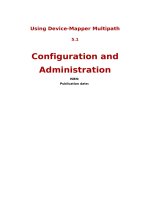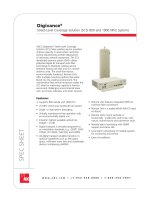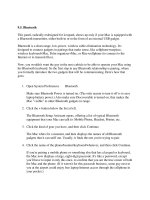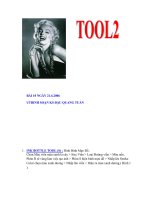Tài liệu Learning_VB_Script pptx
Bạn đang xem bản rút gọn của tài liệu. Xem và tải ngay bản đầy đủ của tài liệu tại đây (747.07 KB, 56 trang )
Share these FREE Courses!
Why stuff your friend’s mailbox with a copy of this when we can do it for you!
Just e-mail them the link info –
Make sure that you visit the site as well:
•
MORE FREE COURSES
•
Weekly Tool Tips
•
Updated course versions
•
New courses added regularly
So don’t copy files or photocopy - Share!
End User License Agreement
Use of this package is governed by the following terms:
A. License
TrainingTools.com Inc, ("we", "us" or "our"), provides the Licensee ("you" or "your") with a set of digital files in electronic format (together
called "the Package") and grants to you a license to use the Package in accordance with the terms of this Agreement. Use of the package
includes the right to print a single copy for personal use.
B. Intellectual Property
Ownership of the copyright, trademark and all other rights, title and interest in the Package, as well as any copies, derivative works (if any
are permitted) or merged portions made from the Package shall at all times remain with us or licensors to us. This Package is protected by
local and international intellectual property laws, which apply but are not limited to our copyright and trademark rights, and by international
treaty provisions.
C. Single-User License Restrictions
1. You may not make copies of the files provided in the Package
2. You may not translate and/or reproduce the files in digital or print format
3. You may not rent, lease, assign or transfer the Package or any portion thereof
4.
You may not modify the courseware
Copyrights and Trademarks
No part of this document may be reproduced, stored in a retrieval system, or
transmitted in any form or by any means – electronic, mechanical, recording, or
otherwise – without the prior written consent of the publisher.
Netscape Navigator is a trademark of Netscape Communications Corp.
Windows 3.1, Windows 95, Windows NT, and Internet Explorer are trademarks of Microsoft
Corporation.
All trademarks and brand names are acknowledged as belonging to their respective owners.
Published by
XtraNet
Communications Inc.
180 Attwell Dr., Suite 130
Toronto, Ontario, Canada
M9W 6A9
Phone: 416-675-1881
Fax: 416-675-9217
E-mail:
Copyright © 2000 by XtraNet Communications Inc.
All Rights Reserved
Printed in Canada
June 2000
First Edition
1 2 3 4 5 6 7 8
Table of Contents
Learning VBScript i
Chapter 1 - Introduction to VBScript programming.................................................... 1
Interpreted programs vs. Compiled programs................................................................................................ 2
Why Learn VBScript ................................................................................................................................................3
About VBScript ..........................................................................................................................................................3
Client Side Scripting ................................................................................................................................................3
Server Side Scripting............................................................................................................................................... 3
Review Questions ....................................................................................................................................................4
Summary .....................................................................................................................................................................5
Chapter 2 - VBScript Syntax............................................................................................................... 6
Inserting Client Side VBScript into an HTML Page......................................................................................7
Inserting VBScript into an Active Server Page (.asp) ..................................................................................8
Syntax and Conventions ........................................................................................................................................9
Case-sensitivity.....................................................................................................................................................9
White Space.......................................................................................................................................................... 9
Strings and Quotation Marks......................................................................................................................... 10
Brackets, Opening and Closing.................................................................................................................... 10
Comments............................................................................................................................................................ 11
Variable and Function Names .......................................................................................................................12
Reserved Words................................................................................................................................................. 13
Review Questions ..................................................................................................................................................14
Summary ...................................................................................................................................................................15
Chapter 3 - Basic Programming Constructs....................................................................16
Declaring Your Variables .....................................................................................................................................17
Types of Variables.................................................................................................................................................. 17
Supported Datatypes............................................................................................................................................. 18
Using Operators ......................................................................................................................................................19
VBScript Operators ................................................................................................................................................20
Control Structures (Loops and Branches)......................................................................................................21
Branches............................................................................................................................................................... 21
The if statement .............................................................................................................................................21
The switch statement ...................................................................................................................................22
Loops...................................................................................................................................................................... 23
The do while and do until Loops............................................................................................................... 23
The For .. Next Loop..................................................................................................................................... 24
The For Each … Next Loop .......................................................................................................................25
The While … Wend Loop............................................................................................................................ 25
Functions ...................................................................................................................................................................26
Built-in functions .................................................................................................................................................26
Programmer created functions...................................................................................................................... 26
Calling a Subroutine.......................................................................................................................................... 26
Function…End Function.................................................................................................................................. 27
Review Questions ..................................................................................................................................................28
Summary ...................................................................................................................................................................29
Chapter 4 - Objects, Events, and the Document Object Model................. 30
Arrays .........................................................................................................................................................................31
Re-dimensioning an Array ...................................................................................................................................31
Object .........................................................................................................................................................................32
The Document Object Model (DOM)............................................................................................................... 34
Events......................................................................................................................................................................... 37
onClick................................................................................................................................................................... 37
onSubmit............................................................................................................................................................... 37
onMouseOver......................................................................................................................................................38
onMouseOut ........................................................................................................................................................38
onFocus................................................................................................................................................................. 39
Table of Contents
Learning VBScript ii
onChange............................................................................................................................................................. 39
onBlur.....................................................................................................................................................................39
onLoad...................................................................................................................................................................40
onUnload............................................................................................................................................................... 40
Review Questions ..................................................................................................................................................41
Summary ...................................................................................................................................................................42
Glossary.................................................................................................................................................................. 43
Answer Appendix.......................................................................................................................................... 46
Learning VBScript 1
1
Introduction to VBScript Programming
This section will provide you with the basics of what VBScript is, and why you
would use it.
Objectives
1. Interpreted programs versus Compiled programs
2. Why VBScript?
3. What you can use VBScript for
4. About VBScript
Learning VBScript 2
Interpreted programs versus Compiled programs
Before we start discussing the differences between interpreted and compiled, we
have to define the term source code, more commonly referred to as code. The
code is the plain text commands that the program is written in. All programming
languages start out as source code; it is then either interpreted or compiled. The
code that you will create in this course can be considered source code.
Interpreted programming languages tend to be simpler to program but slower to
execute in general. Each time a program is run, it has to be interpreted
(interrogated) line by line, based on the flow of execution (you will see later how
branches and loops affect the flow of execution).
Compiled programming languages have a more complex syntax, and require
more strict programming practices. With a compiled programming language, you
first write the source code, then you feed it to a compiler (a special computer
program), which produces an executable binary program. On the Windows
platform, the output of the compiler usually ends in the ".exe" file extension. The
program that comes out of the compilation process tends to be platform
(operating system) specific. The key benefit for the programmer is that no other
programmer can look at the source code once it is compiled. The other key factor
is that the language used to write the source code becomes irrelevant once it has
been compiled.
Visual Basic is a compiled language, whereas VBScript is an interpreted
language.
Learning VBScript 3
Why Learn VBScript
VBScript is used to create Active Server Pages (ASPs), to create administration
scripts for Windows 95/98/NT, to extend or enhance the functionality of the
Microsoft Office products (like Word and Excel (macros)). It can also be used as
a client side scripting language for Internet Explorer. Netscape does NOT
support VBScript as a client side scripting language.
About VBScript
VBScript is an interpreted programming language that can be embedded into an
HTML web page or used in server side scripting.
Client Side Scripting
VBScript code is executed/interpreted when an event is triggered. When the
code is executed it is interpreted one line at a time. There are a number of events
that will trigger the execution of a VBScript, like clicking on a form button, or the
completion of a web page loading.
Note: Internet Explorer is the only browser that supports VBScript today.
Server Side Scripting
When the web server loads an .asp page from the disk into memory, it
automatically knows to interpret the code in this document. Once the code has
been interpreted, the resulting HTML page is sent to the browser (client) making
the request.
Learning VBScript 4
Review Questions
1. (True or False) VBScript is an interpreted language.
2. Visual Basic is a ______________ programming language.
3. (True or False) Visual Basic and VBScript were created by the same
company.
4. Microsoft Internet Explorer supports the following scripting languages.
a. VBScript
b. Visual Basic
c. BASIC
d. JavaScript
e. C++
f. Perl
5. (True or False) VBScript is supported by a large number of browsers.
Learning VBScript 5
Summary
In this module you learned:
1. VBScript is Interpreted, and Visual Basic is Compiled
2. Why you would use VBScript
3. What you can use VBScript for
4. About the VBScript Language
Learning VBScript 6
2
VBScript Syntax
In this chapter you will learn about the peculiarities of the VBScript language.
These are the details for writing a script that will help you avoid errors while you
are creating your own scripts and learning the basics of the VBScript
programming language.
Objectives
1. Placing VBScript in an HTML page and an Active Server Page
2. Case-sensitivity
3. Whitespace
4. Brackets
5. Comments
6. Variable and Function Names
7. Reserved Words
Learning VBScript 7
Inserting Client Side VBScript into an HTML Page
VBScript is added to an HTML page using the SCRIPT tag. The script tags
should be placed inside the head tag of the document. They can appear
anywhere in the document; but must be before the event that is going to trigger
them. If an older browser looks at a page containing script tags it will ignore
them, as older browsers are written to ignore tags they can't interpret.
VBScript code should also be placed inside an HTML Comment tag set.
E.g. <!-- code -->
When used with VBScripts the ending comment tag will also start with two
slashes REM which is the VBScript code for comment. This tells the VBScript
interpreter to ignore that statement.
This is a standard way for adding VBScript to your HTML pages so that it works
properly for browsers that are VBScript enabled and those that do not support
VBScript.
<HTML>
<HEAD>
<TITLE>Web Page containing VBScript</TITLE>
<SCRIPT LANGUAGE="VBSCRIPT">
<!-- hide VBScript code from browsers that are not VBScript enabled
.
. (VBScript Statements goes here)
.
REM end hiding of VBScript code -->
</SCRIPT>
</HEAD>
<BODY>
(HTML document goes here)
</BODY>
</HTML>
We may also put in a single line of code attached to an event. Events will be
explained later. The general syntax for this structure is:
<HTML_TAG Attribute="option" onEvent="VBScript code statements go
here">stuff in between the opening and closing tag</HTML_TAG>
Learning VBScript 8
Inserting VBScript into an Active Server Page (.asp)
To create an Active Server Page, the file is normally stored with the .asp
extension in a directory on a web server that can process Active Server Pages.
You can blend VBScript with normal HTML when creating your Active Server
Pages. See below:
<%@ Language=VBScript %>
<HTML>
<HEAD>
<META NAME="GENERATOR" Content="Microsoft Visual Studio 6.0">
</HEAD>
<BODY>
<%
dim helloString
helloString = "Hello World!"
%>
<P><% Response.Write helloString %></P>
</BODY>
</HTML>
In the above helloworld.asp page, the first line instructs the server that the default
scripting language used in this page will be VBScript. Internet Information Server
(IIS) uses VBScript as the default scripting language if the language directive is
omitted from a page.
To turn on the server side VBScript interpreter you use the less than followed by
the percent “<%” characters. To turn off the server side VBScript interpreter you
use the percent sign followed by the greater than sign “%>”. Both are indicated in
bold in the above example.
Learning VBScript 9
Syntax and Conventions
Writing in any language follows rules and conventions. For example, the English
language requires that each sentence must contain a subject and verb to be
legitimate. You must also capitalize the first letter of a sentence, and end each
sentence with punctuation such as a period or question mark. This is the syntax,
or grammar of the English language. Each programming language has a similar
set of rules commonly referred to as the syntax.
VBScript has several rules and conventions for its syntax:
Case-sensitivity:
VBScript is a case-insensitive language, meaning that the language will
treat these words the same: example, Example, EXAMPLE
White Space:
VBScript, like HTML, ignores spaces, tabs that appear in statements.
VBScript does, however recognize spaces, tabs, and newlines that are
part of a string. We will talk more about strings later in the course.
x=0 is the same as x = 0
All of these examples will produce the same results. It is a good idea to
put some spacing in your code to make it easier to read.
You do need a space between a programming command/function and the
data it is working on.
Learning VBScript 10
Strings and Quotes:
A string is a sequence of zero or more characters enclosed within single
or double quotes ( 'single',. "double").
The double quotation mark can be found within strings that start, and end
with (are delimited by) single quotes ('He said, "VBScript is an interesting
language." ').
The single quotation mark can be used within a string delimited by double
quotation marks. This syntax will be used quite often through out the book.
For example:
<INPUT TYPE="Button" VALUE="Click Me"
onclick="window.alert('You Clicked me');">
In the example above we have a line of HTML code that uses double
quotes to delimit the tag's attributes. So to create a popup window that
displays the string "You Clicked me" we need to enclose the string within
single quotes. This is done so that the entire VBScript statement is
interpreted and the HTML syntax also remains valid.
Opening and Closing Brackets:
All brackets you open must be closed!
i.e. winpop = window.open('ex1.htm','popup','scrollbars=yes');
if ( x(0) == 10 ) then
x(0) = 0
x(1) = 0
end if
In the above example “x(0)=0” and “x(1)=0” are two different statements.
The round brackets ( ) are part of a special data structure called arrays.
Arrays will be covered later in the course.
The curved brackets ( ) are also used to contain a function or a method’s
arguments, multiple arguments are separated by commas. i.e.
('ex1.htm','popup','scrollbars=yes'). Functions and methods will be
described shortly.
Learning VBScript 11
Comments:
You can create a comment using the REM command or a single quote,
like this:
REM this is a comment
or
‘this is a comment
Continuation Character
You can continue a VBScript statement on the next line using “_”.
If x = 1 or _
Y = 2 or _
Z = 3 then
Multiple Statements
You can put multiple VBScript statements on one line if they are separated
by full colons “:”.
X = 0 : y = 1
Learning VBScript 12
Variable, Subroutine and Function Names
In the next chapter you will be introduced to variables, subroutines and
functions. As the programmer you get to choose and assign the names.
The names of the variables and functions must follow these simple rules.
1. The first character must be a letter of the alphabet (lowercase or
uppercase).
2. The name can contain an underscore “_”, but NOT start with an
underscore.
3. You CANNOT use a number as the first character of the name.
4. Names CANNOT contain spaces.
5. Names CANNOT match any of the reserved words.
The following are examples of valid names:
x
add_two_num
x13
We recommend that you use descriptive names for your variables and
your functions and that you adopt a standard way of naming things. The
two formats that are common are; using the underscore to replace spaces,
or capitalizing the first letter of complete words after the first word in the
name. For example:
add_two_num
addTwoNumbers
Learning VBScript 13
Reserved Words
There are a number of words that make up the components of the
VBScript language. These words cannot be used for variable or function
names because the program interpreter would be unable to distinguish
between a default VBScript command and your variable or function name.
ABS Erase Lset Sgn
and Error Ltrim Sin
Array Exit Mid Space
ASC Exp Minute Sqr
ATN Fix mod Static
Call For Month Step
Cbool Function Next Str
Cbyte Hex not StrComp
Cdate Hour Nothing String
CDbl If Now Sub
Chr imp Null Tan
Cint instr Oct Then
Clng Int On Time
Cos is or Timer
Csng IsArray Preserve TimeSerial
Cstr IsDate Private TimeValue
CVErr IsEmpty Public Trim
Date IsNull Randomize Ubound
Dateserial IsNumeric ReDim Ucase
Datevalue IsObject Rem Until
Day Lbound Resume Val
Dim Lcase Right VarType
Do Left Rnd WeekDay
Else Len Rset Wend
Empty Let Rtrim While
End Log Second Xor
eqv Loop Set Year
FALSE
TRUE
Learning VBScript 14
Review Questions
1. Which of the following are valid variable or function names:
a. y
b. 100percent
c. a big number
d. public
e. subtractTwoNumbers
f. First_Name
2. True or False. VBScript is a case insensitive language.
3. True or False. It is a good idea to add comments to your program code.
Learning VBScript 15
Summary
1. VBScript is placed within the <SCRIPT> tags
2. VBScript is case-insensitive
3. VBScript ignores whitespace
4. How and why you should put comments in your program code
5. What names you can use for variables and function names
6. What words are reserved as part of the VBScript language
Learning VBScript 16
3
Basic Programming Constructs
In this chapter you will learn the basics constructs of programming. These
constructs are similar in a number of programming languages, and will be used in
a number of our scripts in later chapters.
Objectives
1. Declaring Variables
2. Using Operators
3. Creating Control Structures ( Branches and Loops )
4. Functions ( Built-in and programmer-created)
Learning VBScript 17
Declaring Your Variables
A variable is a name assigned to a location in a computer's memory to store
data. Before you use a variable in a VBScript program, you should declare its
name. Variables are declared with the dim keyword, like this:
dim x
dim y
dim sum
You can also declare multiple variables with the same dim keyword.
dim x, y, sum
The initial value of the variable is empty, a special value in VBScript.
Dim is short for dimension. When you declare a variable the interpreter needs to
allocate memory to hold the contents for you. In strongly typed languages (which
VBScript is not) the interpreter or compiler will know what the dimension (size of
memory) is required to hold the value is based on the data type. In VBScript no
memory is allocated until you store a value in the variable.
Types of Variables
A big difference between VBScript and other languages like Visual Basic and C
is that VBScript is untyped. This means that a VBScript variable can hold a value
of any data type, and its data type does not have to be set when declaring the
variable. This allows you to change the data type of a variable during the
execution of your program, for example:
dim x
x = 10
x = "ten"
In this example the variable x is first assigned the integer value of 10, and then
the string value of the word ten.
Learning VBScript 18
The following is a list of data types supported by VBScript
Datatype Description
Empty Variant is uninitialized. Value is either 0 for numeric variables or
a zero-length string ("") for string variables.
Null Variant intentionally contains no valid data.
Boolean Contains either True or False.
Byte
Contains integer in the range 0 to 255.
Integer
Contains integer in the range -32,768 to 32,767.
Currency
-922,337,203,685,477.5808 to 922,337,203,685,477.5807.
Long
Contains integer in the range -2,147,483,648 to 2,147,483,647.
Single
Contains a single-precision, floating-point number in the range -
3.402823E38 to -1.401298E-45 for negative values; 1.401298E-
45 to 3.402823E38 for positive values.
Double
Contains a double-precision, floating-point number in the range -
1.79769313486232E308 to -4.94065645841247E-324 for
negative values; 4.94065645841247E-324 to
1.79769313486232E308 for positive values.
Date
(Time)
Contains a number that represents a date between January 1,
100 to December 31, 9999.
String
Contains a variable-length string that can be up to approximately
2 billion characters in length. ie. "The quick brown fox jumped
over the lazy brown dog."
Object
Contains an object.
Error
Contains an error number.
Learning VBScript 19
Using Operators
Operators are the things that act on variables. We have already seen an operator
used in the previous example, where we were assigning values to our variables.
The example used one of the most common operators, "=" or the assignment
operator. Another operator would be the addition operator "+".
dim x, y, sum
x = 1: y = 3: sum = 0
sum = x + y
This small chunk of VBScript code will declare the variables x, y and sum and
assign the number 1 to x, 3 to y and 0 to sum. The next line of the script will add
x to y and assign it to sum. The value of the sum variable will be 4.
Other operators are used to compare things, i.e. "=" equality, ">" greater than.
For example,
if ( sum = 0 ) then
sum = x + y
end if
This bit of code first checks to see if sum is equal to zero, and if so then it adds x
and y together and assigns the result to sum. The "if" statement is an example of
a control structure which we will examine shortly.
Learning VBScript 20
VBScript Operators
Computational
These are probably the most common operators. They are used for
common mathematical operations.
Multiplication ( * )
Division ( / )
Modulo arithmetic ( Mod )
Addition ( + )
Subtraction ( - )
Logical
These operators are very commonly used in conditional statements like “if”
and “switch” that you will be learning about shortly.
Logical NOT ( NOT )
Less than ( < )
Greater than ( > )
Less than or equal to ( <= )
Greater than or equal to ( >= )
Equality ( = )
Inequality ( <> )
Logical AND ( and )
Logical OR ( or )
Logical XOR ( Xor)
Assignment
It is important to note that the single equal sign is used for assignment and
for testing equality
Assignment ( = )









